

Exploratree by Futurelab. Exploratree - Exploratree by FutureLab. Visuwords™ online graphical dictionary and thesaurus. Peet's Coffee & Tea. Yemen Ismaili Coffee. Coffee producing countries and regions. Food-Info.net> Products > Coffee Coffee is produced in over 70 countries worldwide.

Many of these countries have different regions with distinct types of coffee. The following list shows the main coffee producing countries, the main type of coffee grown and some well known local blends. Coffee is normally traded in bags of 60 kilo. Figures are approximate numbers. Regions where arabica coffee is grown (Source) Regions where robusta coffee is grown (Source) Bolivia Coffee types : Arabica Production : 150.000 bags With a landscape of snowy mountains, wide plateaus and tropical rain forests, Bolivia has ideal coffee-producing conditions. Brazil Coffee types : Arabica, Robusta Production : 35.000.000 bags Vast plantations of millions of trees cover the hills of south-central Brazil. Bourbon Santos. Rio. Burundi Production : 500.000 bags Burundi possesses a tropical climate very convenient to the arabica coffee farming.
Cameroon Production : 1.000.000 bags Central African Republic Coffee types : Robusta. Yemeni Coffee. Yemen is the only country in which coffee is grown in a climate and an environment which are not similar to those in which coffee trees are cultivated in other areas around the world .

Welcome to Al-Hamdani Coffee Website. About Yemen Coffee. Yemen coffee. Coffee. Coffee is a brewed beverage prepared from the roasted or baked seeds of several species of an evergreen shrub of the genus Coffea.

The two most common sources of coffee beans are the highly regarded Coffea arabica, and the "robusta" form of the hardier Coffea canephora. The latter is resistant to the coffee leaf rust (Hemileia vastatrix), but has a more bitter taste. Coffee plants are cultivated in more than 70 countries, primarily in equatorial Latin America, Southeast Asia, and Africa. Once ripe, coffee "berries" are picked, processed and dried to yield the seeds inside. The seeds are then roasted to varying degrees, depending on the desired flavor, before being ground and brewed to create coffee.
Coffee is slightly acidic (pH 5.0–5.1[1]) and can have a stimulating effect on humans because of its caffeine content. Etymology[edit] The Coffees of Yemen. The mountainous strong-hold is typical for rural Yemeni towns like Hajja Appearance.5 d/300gr, 15+ Screen Graden/a ProcessingDry Process (Natural) RegionHajja District Varietal(s)Heirloom Varietals RoastCity+ to Full City+: Fruited notes prevail throughout the spectrum with layered complexity.

Mocha, Yemen. Mocha or Mokha (Arabic: المخا al-Mukhā Yemeni pronunciation: [elˈmoχæ]) is a port city on the Red Sea coast of Yemen.
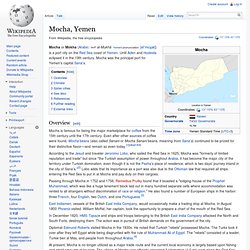
Until Aden and Hodeida eclipsed it in the 19th century, Mocha was the principal port for Yemen's capital Sana'a. Overview[edit] Mocha is famous for being the major marketplace for coffee from the 15th century until the 17th century. Even after other sources of coffee were found, Mocha beans (also called Sanani or Mocha Sanani beans, meaning from Sana'a) continued to be prized for their distinctive flavor—and remain so even today.[1][dead link] Yemeni Customs (table manners) Traditional Yemeni main dishes. Yemeni cuisine. Yemeni cuisine is entirely distinct from the more widely known Middle Eastern cuisines and even differs slightly from region to region.
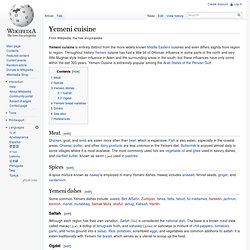
Throughout history Yemeni cuisine has had a little bit of Ottoman influence in some parts of the north and very little Mughlai-style Indian influence in Aden and the surrounding areas in the south, but these influences have only come within the last 300 years. Yemeni Cuisine is extremely popular among the Arab States of the Persian Gulf. Meat[edit] Spices[edit] A spice mixture known as hawaij is employed in many Yemeni dishes. Yemeni dishes[edit] Saltah[edit] Ogdat[edit] Yemeni bread varieties[edit] Religion In Yemen. The World Factbook. Geography of Yemen.
Topographic map of Yemen Wadi Dhar Agricultural terraces.
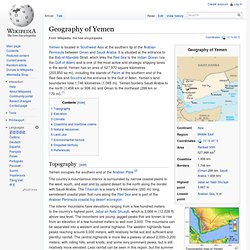
Women in Yemen. Women in Yemen have historically had much less power in society than men.
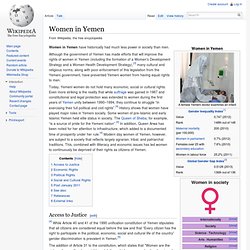
Although the government of Yemen has made efforts that will improve the rights of women in Yemen (including the formation of a Women's Development Strategy and a Women Health Development Strategy),[3] many cultural and religious norms, along with poor enforcement of this legislation from the Yemeni government, have prevented Yemeni women from having equal rights to men. Today, Yemeni women do not hold many economic, social or cultural rights. Even more striking is the reality that while suffrage was gained in 1967 and constitutional and legal protection was extended to women during the first years of Yemen unity between 1990–1994, they continue to struggle “in exercising their full political and civil rights”.[4] History shows that women have played major roles in Yemeni society. Some women of pre-Islamic and early Islamic Yemen held elite status in society. Access to Justice[edit] Economic Rights[edit]
Religion in Yemen. Yemen holds close to their religion, which for the most part is Islamic.
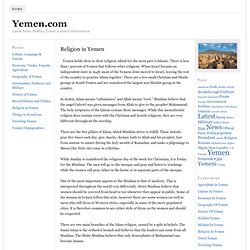
There is less than 1 percent of Yemen that follows other religions. When Israel became an independent state in 1948, most of the Yemeni Jews moved to Israel, leaving the rest of the country to practice Islam together. There are a few small Christian and Hindu groups in South Yemen and are considered the largest non Muslim group in the country. In Arabic, Islam means “submission” and Allah means “God.” Muslims believe that the angel Gabriel was given messages from Allah to give to the prophet Muhammad.
Yemen : Location, Map, Area, Capital, Population, Religion, Language - Country Information. Yemen Facts, Yemen Flag. Yemen Facts Flag Map Ancient kingdoms flourished in southwestern Arabia (now Yemen), a crossroads of trade from the Orient and Africa to the Mediterranean. At the time of Christ, camel caravans carried as much as 3,000 tons of frankincense each year to Greece and Rome. Marib, capital of Saba (biblical Sheba), was the queen city of incense; nearby a huge dam irrigated thousands of hectares of farmland.
Today a new dam and oil pump life into Marib. Yemen Map. Yemen Guide. Map of Yemen - Asian Maps, Asia Maps Yemen Map Information. Over many centuries the ancient land of Yemen proved irresistible to fortune seekers and hostile empires from far and wide.
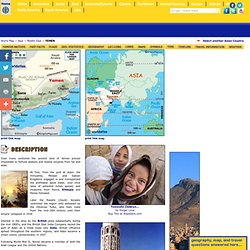
At first, from the port at Aden, the Himyarite, Minean and Sabian Kingdoms engaged in and monopolized the profitable spice trade; over time tales of potential riches spread, and invasions from Rome, Ethiopia and Persia followed. Country of Yemen Information, Yemen Rentals, Yemen Demographics, Yemen Recreation, Yemen Culture, Yemen Attractions, Yemen History, Yemen Tourist Information, Yemen Transportation. Yemen: Maps, History, Geography, Government, Culture, Facts, Guide & Travel/Holidays/Cities. Republic of Yemen Formerly divided into two nations, the People's Democratic Republic of Yemen and the Yemen Arab Republic, the Republic of Yemen occupies the southwest tip of the Arabian Peninsula on the Red Sea opposite Ethiopia and extends along the southern part of the Arabian Peninsula on the Gulf of Aden and the Indian Ocean.
Saudi Arabia is to the north and Oman is to the east. The country is about the size of France. A 700-mile (1,130-km) narrow coastal plain in the south gives way to a mountainous region and then a plateau area. Parliamentary republic. The history of Yemen dates back to the Minaean (1200–650 B.C. ) and Sabaean (750–115 B.C. ) kingdoms. The northern portion of Yemen was ruled by imams until a pro-Egyptian military coup took place in 1962. Yemen. Yemen i/ˈjɛmən/ (Arabic: اليَمَن al-Yaman), officially known as the Republic of Yemen (Arabic: الجمهورية اليمنية al-Jumhūriyyah al-Yamaniyyah), is an Arab country in Western Asia, occupying the southwestern to southern end of the Arabian Peninsula.
Yemen is the second largest country in the peninsula, occupying 527,970 km2 (203,850 sq mi). The coastline stretches for about 2,000 km (1,200 mi).[5] It is bordered by Saudi Arabia to the north, the Red Sea to the west, the Gulf of Aden and Arabian Sea to the south, and Oman to the east. Its capital and largest city is Sana'a. Yemen's territory includes more than 200 islands. The United States considers AQAP to be the "most dangerous of all the franchises of Al-Qaeda".[17] The U.S sought a controlled transition that would enable their counter-terrorism operations to continue.
Etymology[edit]
Getting started.